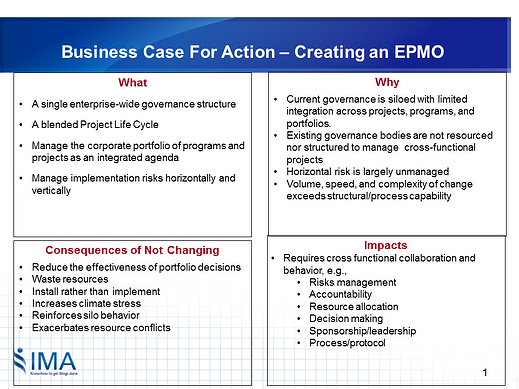One of the common strategic changes we see in our change management consulting is the attempt to implement EPMOs (Enterprise Program Management Offices.) Why the interest in EPMOs? What problem is the EPMO trying to solve? For many organizations, the establishment of an EPMO is an attempt to drive greater collaboration across the enterprise and overcome the traditional silos. This is an admirable objective, but what does it take from a change management consulting perspective? 
The EPMO is a singular, enterprise-wide governance structure that is tasked with managing the corporate portfolio of programs and projects as an integrated change agenda. This is much needed because too many organizations lack any real, accurate insight into exactly what changes are being implemented at any given time. This leads to inefficient use of resources, duplicative efforts, and under-resourced changes.
Significantly, as organizations attempt more enterprise-wide changes like shared services, or implementation of collaborative tools like Sharepoint, they discover pretty quickly that their existing governance bodies are not resourced or structured to really manage cross-functional projects. This leaves the organization vulnerable to unmanaged risks when changes move horizontally across the traditional vertical silos or "stovepipes."
It just makes sense that if you are looking to implement complex, even transformational changes horizontally, the governance should reflect the process. Otherwise, the organization leaves itself open to risks including:
- reduced effectiveness of portfolio decisions
- wasted resources
- changes that are "installed" but not "implemented," and therefore do not achieve full benefit realization
- increased organizational "stress" that can slow down both current
 and future changes
and future changes - a reinforced "silo mentality" where decisions are made from a narrow rather than enterprise viewpoint
- continued conflicts over best use of resources
What our change management consulting work highlights is that organizations may not fully comprehend that the establishment of an EPMO is both a process change and a cultural change. More specifically, the EPMO requires a significant behaviorial shift that will impact areas like:
- risk management
- accountability
- resource allocation
- decision-making
- sponsorship and leadership behaviors
- process and project management protocols
Given that creation of the EPMO requires behavioral as well as process changes, it's extremely useful to follow a structured framework like AIM (Accelerating Implementation Methodology) to the implementation. As with any other change, the definition must be fleshed out to identify the technical, business and the human objectives. Ultimately, reinforcements will need to be put in place to reinforce the new behaviors (the human objectives) that reflect this cross-functional governance approach.
Otherwise, you can have an EPMO but you won't get to the desired collaboration. In our change management consulting work, we have helped clients identify what these new, cross-functional behaviors look like. This answers the question: How would you know "cross-functional behavior" if you saw it?
Here's an example:
New Behavior: Pursues the common interest (i.e., enterprise-wide) even at the expense of local position or preference
a. Collaboratively determines scope, goals, expectations, problems
b. Works toward a common outcome by seeking to meet common needs first
There are other descriptors, but this gives an idea of the level of detail that is needed for defining the change. The business case for an EPMO is strong, but like any other change, it requires attention to the behavioral dimensions. Without:
- a complete definition of the change (what's in, what's out) and the descriptions of both current and future state (From...To)
- a plan for generating Sponsorship across all impacted areas
- a plan for building readiness and managing the inevitable resistance
- a plan for communicating what the change is in the Frame of Reference of each group of Targets, and
- a plan for reinforcing the new behaviors (positive and negative consequences, and making it easier to follow the new processes than to keep doing things in the old ways)
...you may have an EPMO that doesn't achieve the full range of desired benefits.


